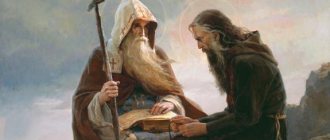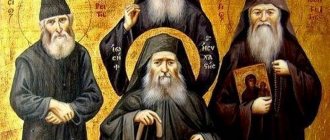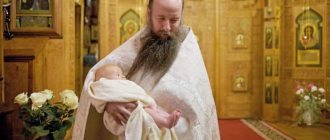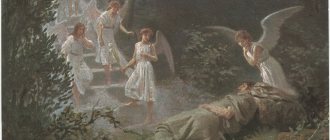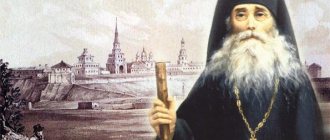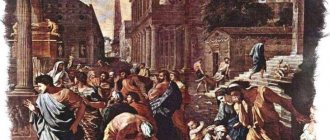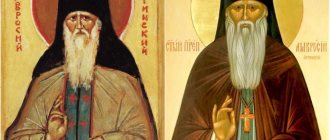The Putilov brothers - founders of the Optina monastery
On December 26, the Church celebrates the discovery of the relics of the Venerables Moses and Anthony, the elders of Optina.
Reverends Moses and Anthony (in the world Timothy and Alexander Putilov) opened a new page in the history of Optina Hermitage. Together with the elders Lev (Nagolkin) and Makariy (Ivanov), they turned a small monastery, lost in the forests of Kaluga, into the spiritual center of Russia in the mid-19th - early 20th centuries.
The brothers came from a pious family. Their father, Ivan Grigorievich, raised his children in a Christian spirit, but did not want to see them become monks. He forcibly married off his eldest daughter Anisya, who wanted to join the monastery. She soon died (in 1800), and her husband went to the Sarov hermitage, where at that time the Monk Seraphim of Sarov labored. There, against the will of their father, the eldest sons Timofey and Jonah entered in 1805 (their father came to terms with their decision only on his deathbed).
At the beginning of their spiritual formation, the older Putilov brothers were greatly influenced by Moscow ascetics: the nun Dosifeya (according to legend, Princess Tarakanova) and the elders of the Novospassky Monastery Alexander and Filaret, whom Timofey and Jonah met even before entering the monastery during their short service in Moscow . It was the Moscow elders who blessed Timothy to move to the Svensky Monastery of the Oryol diocese. This happened in 1808. Brother Jonah (in monasticism Isaiah) remained in the Sarov monastery and subsequently became its abbot.
The disciples of Elder Paisius (Velichkovsky) labored in the Svensky Monastery. Many of the inhabitants of the monastery then continued their feat in the nearby Roslavl forests. In 1811, Timothy also went to the forest monastery, becoming a disciple of Elder Athanasius, an experienced ascetic and prayer book. Here he took monastic vows with the name Moses, in honor of the Monk Moses Murin.
The hermits performed daily services in their cells, and on Sundays and holidays they gathered together for divine services. The time was spent in work and prayer. Father Moses read the ascetic works of the holy fathers, copied liturgical books and translations of patristic works made by Elder Paisius. Occasionally, visitors came to whom the ascetics gave spiritual instructions.
In 1816, Alexander Putilov arrived at the same forest monastery, becoming a novice under his brother. This spiritual guidance lasted throughout my life. Later, Alexander was tonsured with the name Anthony, in honor of St. Anthony the Great.
In 1820, on a trip to Moscow, Father Moses visited Optina Pustyn, where he met with the ruling bishop of the Kaluga diocese, Filaret (Amphiteatrov). The Bishop had long wanted to establish a secluded monastery in Optina and entrust this to the hermits of Roslavl, knowing about their ascetic life. The Bishop liked Father Moses for his humility and spiritual prudence. On June 6, 1821, with several monks (including Father Anthony), the Monk Moses arrived in Optina Pustyn.
The first step was to clear the space for the future monastery. Then a temple in the name of the holy prophet John the Baptist and a cell were built. Bishop Filaret came to consecrate the temple at the beginning of 1822. Father Moses asked him for permission to take monastic vows, but Vladyka insisted on accepting the priesthood. On December 22, 1822, Father Moses was ordained as a hieromonk and appointed confessor to Optina, continuing to organize the Baptist monastery.
Father Moses loved flowers very much, so many different types of flowers and trees were planted on the territory, which over time became a real decoration of the monastery. Father Anthony worked in various obediences, being subordinate to his brother. On August 24, 1823, he was ordained by the Bishop as a hierodeacon, and in 1827 as a hieromonk.
In 1825, Father Moses was elected rector of Optina Pustyn. The monk himself later recalled that he agreed to the abbotship, intending to remain in this position for ten years, and then live in solitude. But he had to endure the labor of managing the monastery until the end of his days.
During this time, the monastery was literally transformed. The building of the Vvedensky Cathedral was expanded, two side chapels were built. The church of St. Mary of Egypt was built in the fraternal refectory, and a cemetery church was erected. Inside the temples, the walls were decorated with paintings and the iconostases were updated. The monastery sacristy expanded and was replenished with beautiful vestments. The existing fraternal buildings were improved and expanded and seven more were rebuilt; A stone fence with seven towers, a large building for the fraternal meal, and a new stone building of the monastery library were erected. The abbot himself took care of replenishing it with books. In addition to spiritually beneficial literature, Father Moses acquired books on various fields of knowledge.
Pilgrims received a warm welcome in Optina: new hotels were built for them (eight buildings with three outbuildings). From the economic establishments there appeared two horse yards with fraternal cells, a cattle yard, a mill, a brick and tile factory. The monastery's land holdings almost doubled. On the land granted to the monastery in 1853, a farm was built for hay collection and fishing.
All these extensive transformations and constructions began with virtually no money. The abbot, believing in the Providence of God, could undertake the construction of a new building with only some 15 rubles, but funds appeared over time and construction continued.
When Father Moses took over the management of the monastery, Vladyka Philaret appointed Father Anthony as the head of the monastery. He was only thirty years old, and many monks, older in age and occupying higher levels of monasticism, were under his command. But, despite his young years, he knew how to deal with everyone so as not to offend anyone. In addition, he himself set a convincing example of obedience, obeying the abbot in everything.
Both the abbot and the monastery commander paid the main attention to arranging the spiritual life of the monastery. With the assistance of Father Moses, Elder Lev (Nagolkin) settled in the monastery in 1829, followed by his disciple Father Macarius (Ivanov). Both Abbot Moses and Father Anthony handed over the spiritual leadership of the monastery and monastery to the elders, and they themselves entrusted themselves to their care. Thus, by personal example, they recreated in Optina a forgotten tradition, which had been the basis of monastic life since ancient times. The old brethren, not familiar with this institution, expressed dissatisfaction, perceiving the rules of obedience to the elder and revelation of thoughts as some kind of “newfangled teaching.” Denunciations and complaints rained down on the abbot and elders. The period from 1835 to 1851 was especially difficult, when the Kaluga See was ruled by Bishop Nikolai (Sokolov). The Bishop intervened not only in economic affairs. He hindered the activities of the elders in every possible way, and the abbot was deprived of the right to tonsure monks and appoint them to various positions at his own discretion. Monks who succeeded in spiritual life were transferred to other monasteries by order of the bishop. So in 1839, the monastery's leader, Father Anthony, was sent to the post of abbot of the Maloyaroslavets monastery and was able to return to Optina only in 1853. Father Moses withstood this many-year test, seeing in it Divine Providence, directing him to fight his own passions.
The Monk Moses can be called an exemplary abbot. He uniquely managed to combine true non-covetousness and tireless care for the needs of the monastery. His entire “economic policy” was based on complete submission to the will of God and service to one’s neighbor. As a result, the neglected small monastery turned into a monastery famous for its prayer books, where a beggar could always find shelter and bread, looking for spiritual food - wise instruction, confused in everyday circumstances - reasonable guidance.
Father Anthony, being the head of the monastery, provided enormous assistance to his brother in establishing the monastery. When he returned to Optina again after being abbot of the Maloyaroslavets Monastery, many of his spiritual gifts were revealed. This is how Father Clement (Zederholm) remembers him: “He did not despair of correcting anyone and knew how to raise up careless and cowardly people, and no matter how discouraged someone was, he always managed to instill hope in his conversations. In his advice and instructions he was extremely careful and pointed to the words of Saint Isaac the Syrian that it is necessary to treat people as if they were sick and to reassure them as much as possible, and not to reprove them, for this upsets them more than brings them benefit.
Father Anthony was loved by everyone in Optina without exception. He remembered the Angel Day of each of the inhabitants of the monastery, congratulated them and gave small gifts. They said that even the sight of him instilled peace and tranquility in the souls.
In the spring of 1862, Father Moses became seriously ill. On June 6 he was tonsured into the schema, and on June 16 he quietly departed to the Lord. The death of his brother undermined the strength of Father Anthony. On March 9, 1865, he was tonsured into the schema. From that time on, the elder became even more secluded, feeling that his exit from this life was not far off. He stopped receiving lay persons, and began to receive brethren less often. Father Anthony constantly felt the presence of his brother around him. Their souls talked mysteriously, and almost not a day passed without the deceased appearing to him in a dream.
Elder Anthony died on August 7 (20), 1865 and was buried next to his brother in the Kazan Cathedral of the monastery.
Optina Pustyn
You are overcome with awe when you think how sacred this land is - this small section of Russian spaces on which the St. John the Baptist Skete of the Holy Vvedenskaya Optina Hermitage is located! It is not surrounded by a fence of stone or wood, preserving within itself, despite all the catastrophic turns of history, the gracious peace of Christ, but by living, unceasing prayer that reaches heaven: the prayers of the great venerable elders of Optina, many generations of monks who lived here, pilgrims who gathered here from all over Holy Rus'. The monastery was the heart of Optina Pustyn - the place where the pulse of its life beat, from where came the grace-filled power that sanctified the lives of the inhabitants of the monastery.
Entrance to the Forerunner Skete. Archive photo
Ancient engraving. View of the Forerunner Skete
The beginning of desert living here was laid by Schemamonk Ioannikis, who lived at the beginning of the 19th century. in the depths of the monastery forest in a small apiary. Six years after his death, the hermits of the Roslavl forests moved here, among whom were the elders
, who were entrusted with the construction of Skeet. O. Moses and his brethren had a huge amount of work ahead of them: they had to clear a huge area of centuries-old pine trees to build a monastery. Both brothers - Fr. Moses and Fr. Anthony, together with hired workers, felled pine trees and uprooted stumps. Gradually, separate houses of fraternal cells appeared on the sides of the temple. Fruit trees and pine nuts were planted, which turned into slender trees and bore fruit after 25 years.
Interior view of the Forerunner Skete. Archive photo
It was in the monastery that the elder leadership was born, but Rev. Moses was overloaded with complex abbot duties, and Anthony was in poor health to take over the leadership of the eldership. This required a person experienced in spiritual-ascetic life, possessing the gift of reasoning, firm and courageous, who could overcome all obstacles on the path to its establishment. This is exactly what Elder Leo turned out to be.
The beginning of the 1840s can be considered the time of complete establishment of eldership. The eldership became stronger thanks to the activities of Rev. Macarius, and reached its peak under St. Ambrose. It was the gracious care of the elderly that attracted many people of different estates and classes here. How many tears were shed here, how many sincere confessions were made, how many demonic bonds were broken, how many hopes were revived! The people had great love for the elders. Ordinary people treated them with complete trust and addressed all their spiritual and economic needs. That is why the flow of people seeking advice and consolation from the gracious Optina elders did not dry out, and that is why Optina Pustyn gained its fame throughout Holy Rus'.
Modern view of the Forerunner Skete
The appearance of the monastery is quite accurately depicted by Dostoevsky in The Brothers Karamazov. A small pink bell tower made of brick rose above the gate; on both sides, outside the fence, there were “huts” - a kind of reception room where the elders went to talk with women: they were forbidden to enter the monastery. Silence reigned within him. It was a beautiful garden, full of colorful flowers growing around the church and cells. In such an environment, the Russian elders cultivated their best spiritual fruits for almost a century. And today the monastery continues to attract many pilgrims with its grace-filled, prayerful silence, just as hundreds of years ago, seeking spiritual guidance and wise advice.
Historical description of the Skete in the name of St. John the Baptist of the Lord, located at the Kozelskaya Vvedenskaya Optina Hermitage (Archimandrite Leonid (Kavelin). 1862)
Modern everyday life of St. John the Baptist Skete of Optina Pustyn
